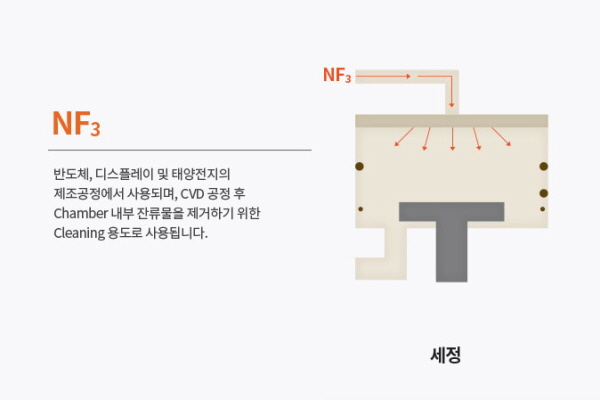반도체용 특수가스인 삼불화질소(NF3)의 공급이 타이트한 가운데 상반기 오버홀 기간 수요공급 밸런스가 무너지면 쇼티지가 발생할 수 있는 상황으로 국내 반도체 생산에 영향을 줄 수 있어 반도체 소재 공급불안이 심화되고 있다.

▲NF3 사용용도(자료 : SK머티리얼즈)
반도체·OLED 등 수요지속증가, 고객사 장기계약 요구
상반기 오버홀 기간 수요공급 밸런스 무너지면 쇼티지
반도체용 특수가스인 삼불화질소(NF3)의 공급이 타이트한 가운데 상반기 오버홀 기간 수요공급 밸런스가 무너지면 쇼티지가 발생할 수 있는 상황으로 국내 반도체 생산에 영향을 줄 수 있어 반도체 소재 공급불안이 심화되고 있다.
반도체용 특수가스 및 소재 업계에 따르면 최근 NF3의 공급이 타이트 한 것으로 알려졌다.
세계 최대 NF3 생산 업체인 SK머티리얼즈의 경우 공급을 맞추기 위해 공장을 풀가동하고 있는 가운데 공정 개선을 지속해 현재의 캐파에서 생산량 증대에 나서고 있고, 효성화학의 경우에도 타이트한 수급 상황을 개선하기 위해 캐파 증설에 나서고 있는 것으로 전해졌다.
업계 관계자들은 지금의 공급 부족 상황은 공급부족이 심각했던 2015년 보다 체감상 더욱 어려운 상황이라고 전달하고 있다. 2015년에도 NF3 쇼티지가 발생해 반도체 생산 공정에 차질을 빚으며, NF3 가격이 폭등했던 적이 있다.
이와 같이 NF3의 공급이 타이트한 이유는 수요가 급증하고 있기 때문이다. 최근 몇 년간의 반도체 증설로 인해 NF3의 사용량이 증가했고, 최근 디스플레이에서도 사용량이 증가하며, 수요가 공급대비 전반적으로 늘었기 때문이다.
특히 삼성전자나 SK하이닉스의 경우 메모리 단수 증가 및 공정 증가로 클리닝 공정이 더 많이 늘었고, 삼성디스플레이의 QLED나 LG디스플레이의 OLED 생산량이 늘어나며, 역시 NF3의 사용량이 급증했다.
이런 가운데 지난해 말부터 시장에 풀리기로 했던 중국산 NF3가 코로나19, 물류 차단 등 여러 복합적인 이유로 시장에 나오지 않았고, 중국에서 대만으로 들어갔던 NF3 물량도 대만 수요를 채우고 한국이나 일본으로 남는 물량이 풀려야 하는데 이마저도 나오지 않아 국내 NF3 공급이 타이트 해진 것이다.
이러한 이유로 2021년 NF3 수입량은 전년대비 24.8% 감소해 국내 반도체 메이커들의 국내 NF3 제조업체에 대한 의존도가 증가했고, 이에 따라 국내 NF3 생산 업체의 증설 요구가 커지고 있다.
이에 반도체 메이커들의 NF3 장기 계약 요구가 최근 급증했고, 가격 또한 지속 급증하고 있는 상황이다.
또한 NF3 생산업체들은 반도체 경기가 ‘상저하고’라는 시장 사이클을 바탕으로 NF3 생산의 안전과 공정 안정성을 유지하기 위해 상반기 오버홀을 계획하고 있는데, 수급 상황이 상당히 타이트해 이러한 시장 사이클 전망이 틀어져 수요공급 예측 상황이 급변할 경우 쇼티지가 발생할 수도 있는 것으로 업계 관계자는 예상했다.
상황이 이러한데도 현재 반도체 업계에서 NF3를 대체할 수 있는 물질은 없는 것으로 판단된다.
대체품으로 거론되고 있는 산화 삼불화아민(F3NO)의 경우 세정력은 NF3보다 낮은데 가격은 높은 것이 단점으로 분석되고 있으며, F3NO를 사용하려고 해도 기존의 반도체 공정을 바꿔야 하는 어려움이 있고, 반도체 공정에서 투자비가 증가해 반도체 메이커들이 채택하기가 쉽지 않을 것으로 분석된다.
이런 가운데 SK머티리얼즈의 경우 수요 증가 분석을 바탕으로 2025년까지 연산 1만8,000톤 규모의 생산 캐파 증설을 계획하고 있고, 효성화학의 경우 현재 연산 8,000톤 규모의 생산량 확보를 목표로 옥산공장에서 2,000톤의 증설을 실시하고 있다.
이와 함께 NF3는 2024년 이후 국내온실가스 규제대상 지정이 예상되는데, 이와 관련해 SK머티리얼즈는 90% 이상 회수 후 잔여가스 처리 설비 구축을 통해 2024년까지 NF3 배출 제로화를 추진한다는 계획을 가지고 있으며, 2030년까지 생산에 있어서 신재생 에너지 적용 100%를 추진한다는 계획도 진행하고 있는 것으로 알려졌다.
한편 NF3는 반도체 생산 공정에서 화학적기상증착법(CVD) 챔버 내에서 웨이퍼에 박막을 입힌 후 남아있는 이산화규소(SiO2)나 질화규소(SiN4)와 같은 불순물과 반응해 사플루오린화규소(SiF4)로 내부를 세척하는데 사용된다.
국내에서는 SK머티리얼즈, 효성화학, 버슘머트리얼즈 등이 생산하고 있으며, 일본 업체인 칸토덴카, 미쓰이화학 등이 공급하고 있다.
